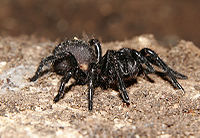
Photo from wikipedia
Australian funnel-web spiders are amongst the most dangerous venomous animals. Their venoms induce potentially deadly symptoms, including hyper- and hypotension, tachycardia, bradycardia and pulmonary oedema. Human envenomation is more frequent… Click to show full abstract
Australian funnel-web spiders are amongst the most dangerous venomous animals. Their venoms induce potentially deadly symptoms, including hyper- and hypotension, tachycardia, bradycardia and pulmonary oedema. Human envenomation is more frequent with the ground-dwelling species, including the infamous Sydney funnel-web spider (Atrax robustus); although, only two tree-dwelling species induce more severe envenomation. To unravel the mechanisms that lead to this stark difference in clinical outcomes, we investigated the venom transcriptome and proteome of arboreal Hadronyche cerberea and H. formidabilis. Overall, Hadronyche venoms comprised 44 toxin superfamilies, with 12 being exclusive to tree-dwellers. Surprisingly, the major venom components were neprilysins and uncharacterized peptides, in addition to the well-known ω- and δ-hexatoxins and double-knot peptides. The insecticidal effects of Hadronyche venom on sheep blowflies were more potent than Atrax venom, and the venom of both tree- and ground-dwelling species potently modulated human voltage-gated sodium channels, particularly NaV1.2. Only the venom of tree-dwellers exhibited potent modulation of voltage-gated calcium channels. H. formidabilis appeared to be under less diversifying selection pressure compared to the newly adapted tree-dweller, H. cerberea. Thus, this study contributes to unravelling the fascinating molecular and pharmacological basis for the severe envenomation caused by the Australian tree-dwelling funnel-web spiders.
Journal Title: International Journal of Molecular Sciences
Year Published: 2022
Link to full text (if available)
Share on Social Media: Sign Up to like & get
recommendations!